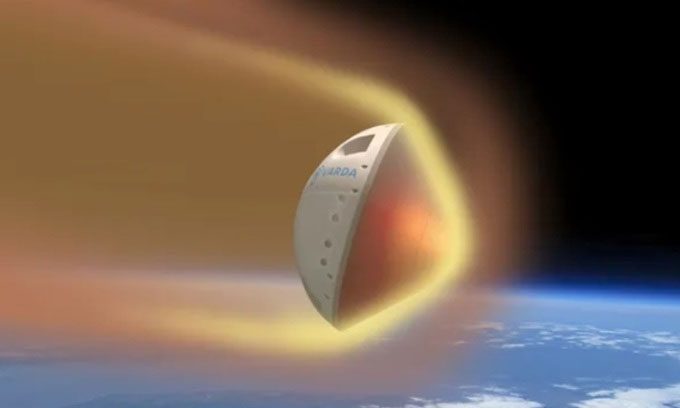The W-1 capsule carrying crystals of HIV and Hepatitis C treatment developed by Varda Space Industries has returned after nearly 8 months in orbit, with a scheduled landing by parachute at 3:40 AM on February 22, according to Hanoi time.
The capsule from the W-1 mission of Varda Space Industries landed in northern Utah on the afternoon of February 21, bringing back crystals of a type of antiviral drug developed in low Earth orbit, as reported by Space. This success makes Varda the third company to recover an intact spacecraft from orbit, following SpaceX with its Dragon vehicle and Boeing with its Starliner capsule.

Simulation of the W-1 capsule during re-entry. (Photo: Varda Space Industries)
Varda plans to become a major player in off-Earth manufacturing, aiming to provide several unique benefits. “Processing materials in a microgravity environment offers a unique setting that ground-based processing lacks. The primary benefits stem from the absence of convection and sedimentation due to gravity, as well as the potential to form more perfect structures due to reduced pressure,” the company stated.
Private companies have previously returned products created in space to Earth. For example, Made In Space in California has repeatedly brought back valuable ZBLAN optical fibers. However, Made In Space produced its fibers on the International Space Station and transported ZBLAN back using SpaceX’s Dragon capsule. Varda aims for a more efficient and cost-effective process with its small, unmanned capsule that serves as both a mini-factory and a return vehicle.
The conical capsule, measuring 0.9 meters in diameter, is integrated with Rocket Lab’s Photon spacecraft (which provides power, propulsion, navigation, and many other services) and launched in June 2023 during SpaceX’s Transporter-8 mission. The W-1 capsule contained the necessary materials to develop Ritonavir crystals, an antiviral drug used for treating HIV and Hepatitis C. This pharmaceutical is among the high-value products that could stimulate and sustain the off-Earth manufacturing industry. Just a week after the Transporter-8 launch, Varda announced that their crystal growth experiment was underway.
Varda intended to bring the crystals back to Earth after 1 to 2 months in orbit. However, the company faced challenges in obtaining re-entry permits from the U.S. Federal Aviation Administration and the U.S. military, which manages the planned landing zones at the Utah Test and Training Range (UTTR) and the Dugway Proving Ground, both located west of Salt Lake City.
Varda received its permit last week, and Rocket Lab began preparations for the W-1 re-entry operation. Photon conducted several engine burns in recent days to place the spacecraft and the W-1 capsule on the correct trajectory for their return to Earth. Since the vehicle was not designed for re-entry, most of the spacecraft burned up, but the W-1 capsule successfully navigated the atmospheric journey and ultimately landed by parachute at UTTR at 3:40 AM on February 22, according to Hanoi time.
From there, the capsule will be transported to Varda’s facility in Los Angeles for post-mission analysis. Data collected from the entire flight will be shared with the U.S. Air Force and NASA under a contract between Varda and these agencies.


















































